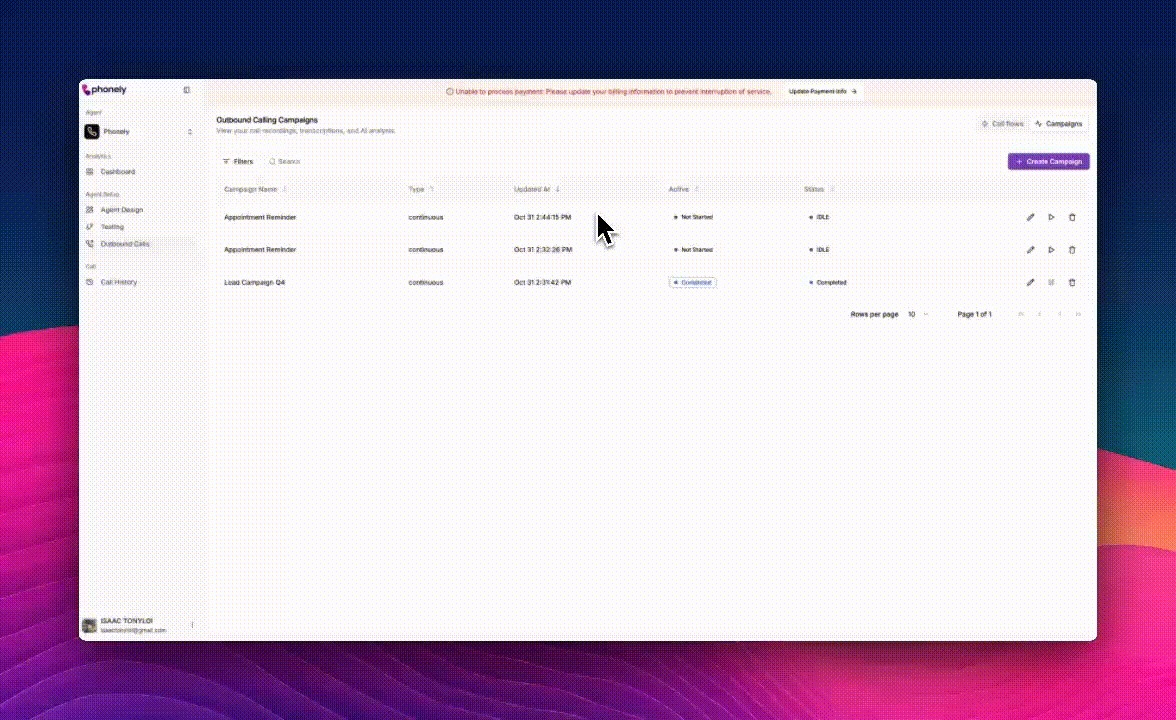
Understanding Outbound Campaigns in Phonely
An outbound campaign is a coordinated series of automated calls initiated by your Phonely AI agent. Each campaign is configured with a purpose (called a use case), assigned specific phone numbers, and given a flow that determines what your AI says and how it responds.Phonely connects with platforms like Twilio for outbound numbers and Google Sheets, webhooks, or CSV uploads for lead sources.Campaigns support both **batch **calling for large lead uploads and **continuous **mode for real-time outreach as new leads sync from your CRM.
1
Define Campaign Information
When you click Create Campaign, you’re first asked to define the identity and intent of your campaign. This will help you organize campaigns and ensure that metrics and compliance requirements are clear later.
Use a descriptive name that conveys purpose.This helps your team quickly find and analyze campaigns later, especially when multiple outbound initiatives are running simultaneously.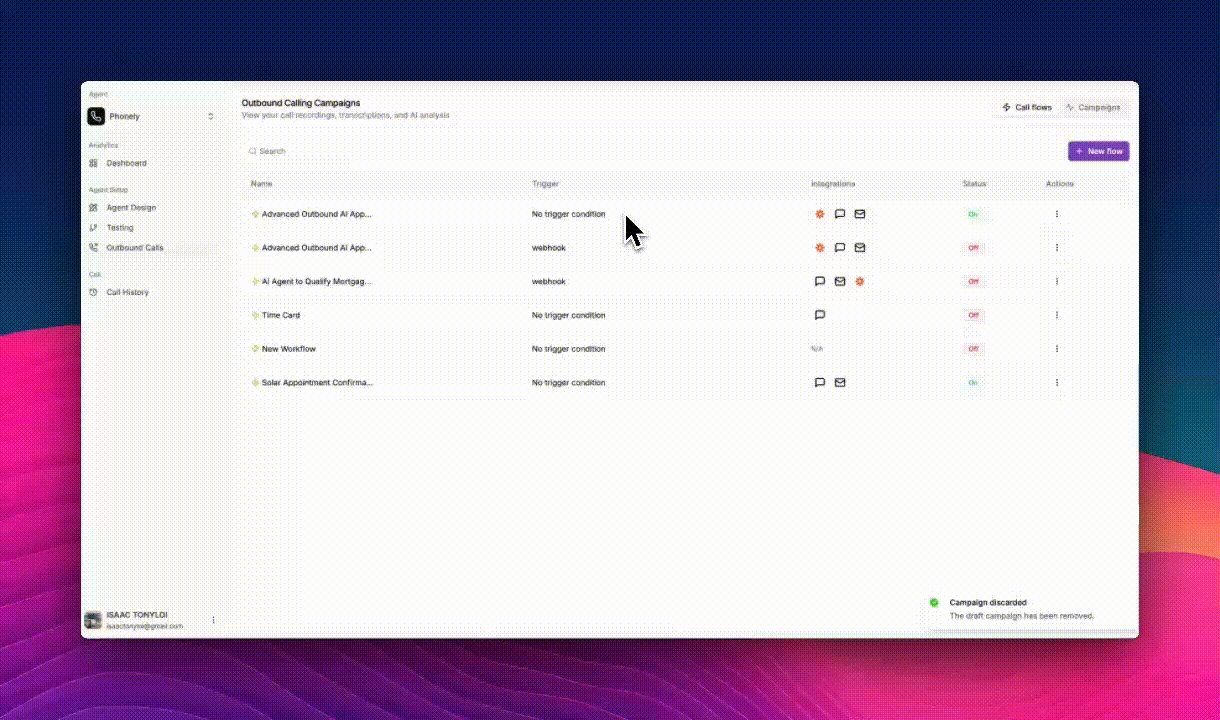
Campaign Name
The campaign name is how Phonely identifies your automation in dashboards and reports.Use a descriptive name that conveys purpose.This helps your team quickly find and analyze campaigns later, especially when multiple outbound initiatives are running simultaneously.
Campaign Use Case
Next, choose a use case. This tells Phonely what kind of automation you’re building. Common use cases include:- Lead Qualification – calling potential customers and gathering initial details.
- Customer Retention – re-engaging existing users or upselling new offers.
- Appointment Reminders – automatically reminding clients of upcoming bookings.
- Feedback Collection – conducting post-service surveys.
- Voicemail Redials – following up with missed or unanswered leads.

2
Add Outbound Numbers
A campaign needs outbound phone numbers that it can use to place calls. These numbers are provisioned through Twilio.When you connect Twilio to Phonely, all your available numbers become visible, allowing you to choose which ones will represent the campaign.
Once authenticated, your Twilio numbers appear in a list.You can then select which numbers to use. The goal here is not just to assign numbers, but to manage how calls will be distributed across them.
Connecting Twilio
When prompted, click Add Numbers > Import from Twilio. You’ll enter your Account SID and Auth Token, which allow Phonely to securely access your Twilio account.Once authenticated, your Twilio numbers appear in a list.You can then select which numbers to use. The goal here is not just to assign numbers, but to manage how calls will be distributed across them.
Your Twilio account must be set up on Autopay with a card that has sufficient funds, for your agent to successfully run an outbound campaign.

Choose Routing Method
Phonely offers three distinct ways to route calls across your outbound numbers:- Weight Routing – The simplest and most common method.
Phonely uses these weights to proportionally distribute calls. - State-Based Routing – Designed for localized campaigns.
Phonely detects the state of the recipient and automatically uses a number that matches that state. This improves answer rates, since recipients often respond more positively to local area codes. If no number matches the caller’s state, Phonely defaults to a random enabled number. - Country-Based Routing – Used for international outreach.
Calls are routed through numbers assigned to the recipient’s country, preserving a local presence and helping with compliance in regions where cross-border calls may be restricted.
As with state-based routing, if no local number exists, Phonely falls back to a random enabled number.
3
Call Cadence
“Call cadence” refers to when and how often your campaign will place calls.
Phonely allows scheduling so your AI never calls outside of approved working hours.You’ll see a week-based grid interface where you can toggle each day on or off and define start and end times (for instance, Monday–Friday, 9 AM–6 PM).You can add multiple blocks per day if you want to include breaks.
These schedules align with your customers’ local time zones, ensuring compliance with “do not disturb” hours.
This feature prevents overwhelming your telephony provider or overloading concurrent call capacity.
Cadence management is critical for maintaining system stability and for ensuring you don’t exceed your provider’s call-per-second thresholds.
Phonely allows scheduling so your AI never calls outside of approved working hours.You’ll see a week-based grid interface where you can toggle each day on or off and define start and end times (for instance, Monday–Friday, 9 AM–6 PM).You can add multiple blocks per day if you want to include breaks.
These schedules align with your customers’ local time zones, ensuring compliance with “do not disturb” hours.
Calls per Hour
You’ll also find a rate control slider that sets the maximum calls per hour.This feature prevents overwhelming your telephony provider or overloading concurrent call capacity.
Cadence management is critical for maintaining system stability and for ensuring you don’t exceed your provider’s call-per-second thresholds.
4
Select Trigger Type
This step determines how Phonely knows who to call and when to trigger those calls.
It’s here that you’ll decide between a continuous, always-on campaign and a finite, one-time batch.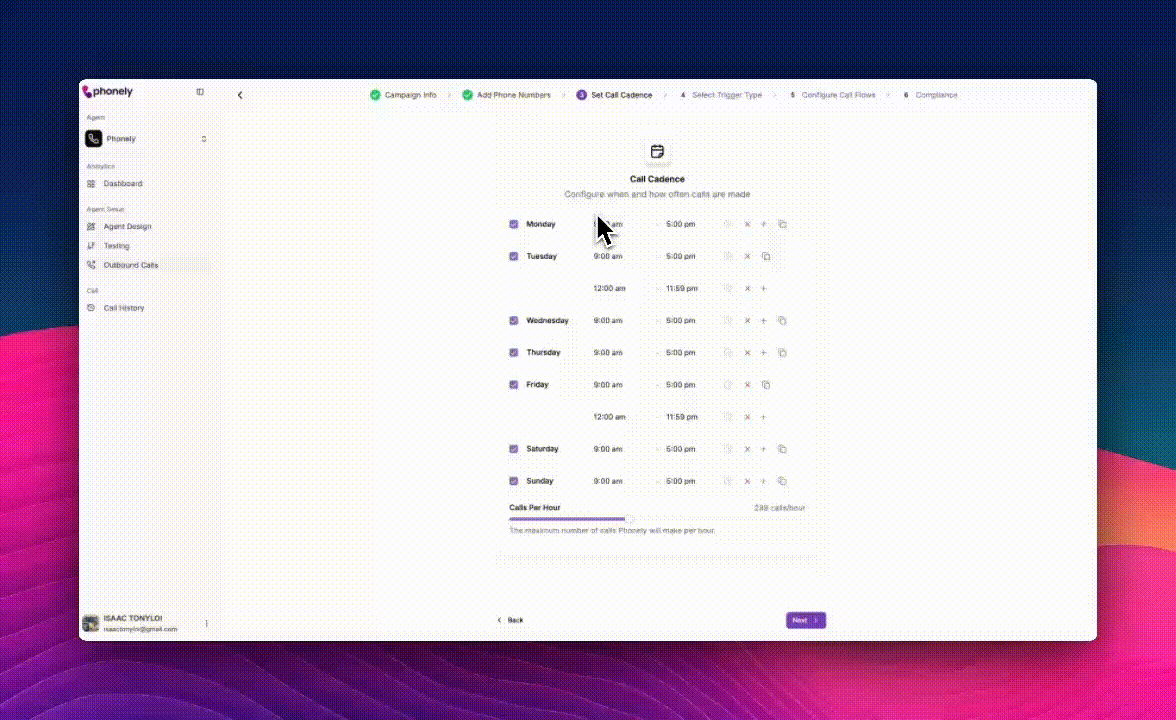
Phonely reads the column headers and lets you map them to variables like name, phone number, or address.Because this runs continuously, it’s ideal for teams managing leads collaboratively in a shared Sheet - the AI will always stay up to date with the latest entries.
Phonely generates a secure URL endpoint that can receive POST requests containing lead data.For example:Each POST instantly adds a new lead to your campaign queue.You can customize the schema and click Update Fields after any changes to ensure Phonely correctly interprets your payload.This option is excellent for developers or CRM systems that want to trigger calls based on specific events - like when a new signup or missed call is logged.
Each row represents a contact record, and at minimum you must include a column labeled.Once uploaded, Phonely processes the list sequentially according to your call cadence.
If you want to reuse the same campaign later with new leads, simply upload another CSV or create a new campaign.
It’s here that you’ll decide between a continuous, always-on campaign and a finite, one-time batch.

Campaign Type: Continuous vs Batch
At the top of this section, you’ll be asked to choose a Campaign Type.- Continuous Calling – This mode automatically calls new leads as they appear in your connected source (like Google Sheets or an incoming webhook).
Whenever a new record is added, Phonely detects it and starts a call within your defined schedule. - Batch Calling – In this mode, you manually upload a fixed list of leads via CSV. Phonely then calls through that entire list until it’s completed. It’s perfect for short campaigns, such as a limited-time promotion or follow-up drive.
Trigger Sources
After you pick the campaign type, Phonely asks you to specify the data source that provides leads. You’ll see three available options.1. Google Sheets
This is the most popular option for Continuous Calling.You’ll authenticate your Google account (or reconnect if needed), then select:- The spreadsheet where your leads are stored.
- The specific tab to monitor.
Phonely reads the column headers and lets you map them to variables like name, phone number, or address.Because this runs continuously, it’s ideal for teams managing leads collaboratively in a shared Sheet - the AI will always stay up to date with the latest entries.
2. Webhook
The Webhook trigger is designed for real-time system integrations.Phonely generates a secure URL endpoint that can receive POST requests containing lead data.For example:
3. CSV Upload
For Batch campaigns, you’ll upload a CSV file containing one or more leads.Each row represents a contact record, and at minimum you must include a column labeled.Once uploaded, Phonely processes the list sequentially according to your call cadence.
If you want to reuse the same campaign later with new leads, simply upload another CSV or create a new campaign.
5
Configure Call Flows
Now that Phonely knows who to call, this step defines what happens during the call.
Your AI agent’s behavior is determined by a Call Flow — a visual, block-based sequence that specifies messages, questions, responses, and follow-up actions.
Each flow contains “prompt blocks” and “logic branches” that the AI uses to guide conversations.You can also open the flow editor to modify dialogue, add fallback paths, or integrate with third-party systems.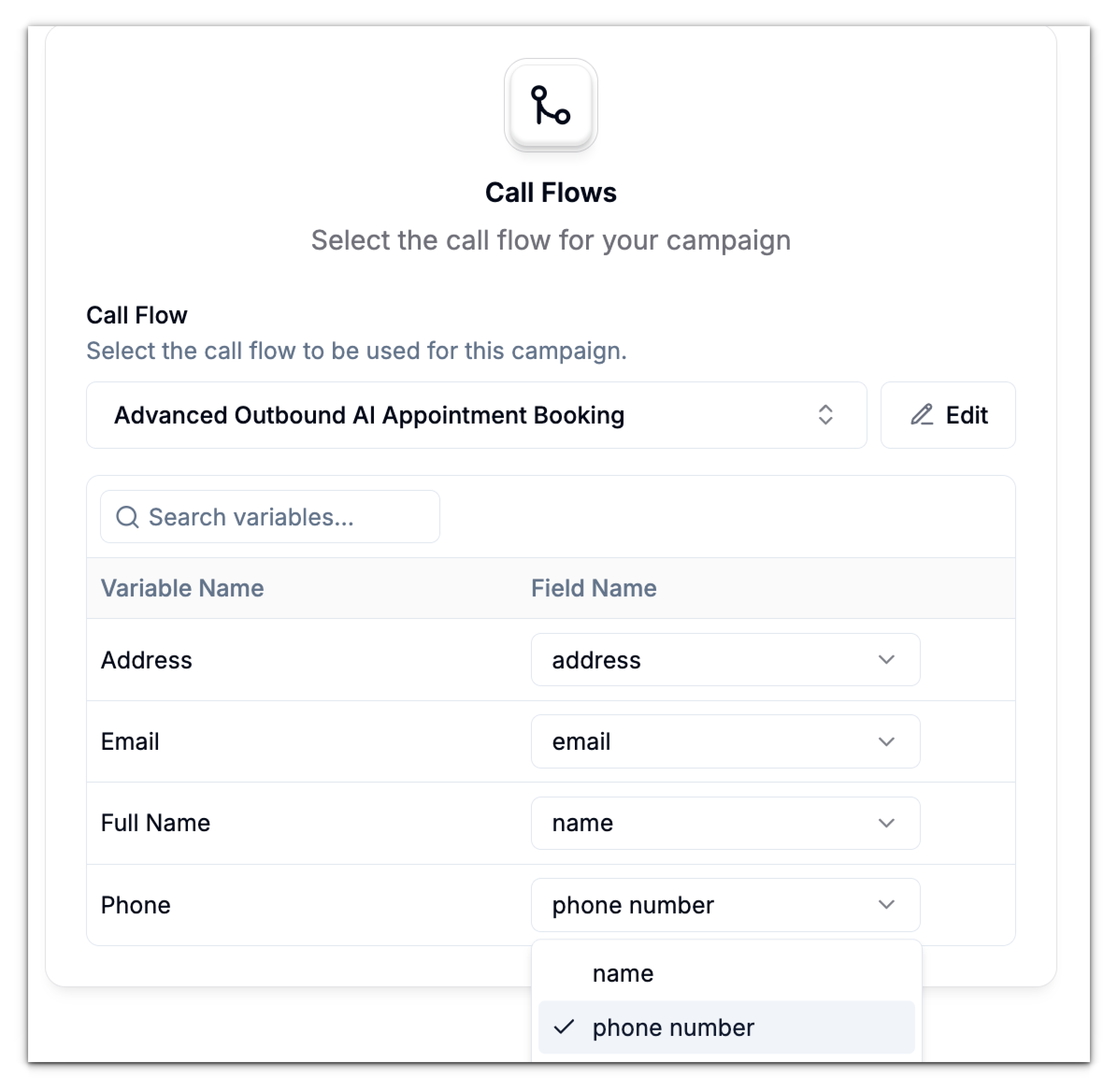
Your AI agent’s behavior is determined by a Call Flow — a visual, block-based sequence that specifies messages, questions, responses, and follow-up actions.
Selecting or Editing a Flow
You can choose an existing flow or create a new one.Each flow contains “prompt blocks” and “logic branches” that the AI uses to guide conversations.You can also open the flow editor to modify dialogue, add fallback paths, or integrate with third-party systems.
Mapping Variables
Phonely detects variables in your flow that require data - such as{name}, {email}, and asks you to map these to fields from your trigger source.For example:
Please note that not all variables need to be mapped, only those you want your agent to reference or use during the call
6
Avoid Spamming - Review Compliance and Legal Confirmation
Outbound calling regulations vary by country, so Phonely includes a mandatory compliance review step before publishing.You’ll see two confirmation checkboxes:
-
General Compliance – You confirm that your campaign abides by relevant telemarketing laws, including:
- Consent from call recipients.
- Adherence to permitted calling hours.
- Accurate identification of your business.
- Maintenance of opt-out and record logs.
-
Do-Not-Call (DNC) Policy – You acknowledge responsibility for ensuring that no prohibited numbers are called.
Phonely screens against common DNC registries, but compliance ultimately rests with the campaign owner.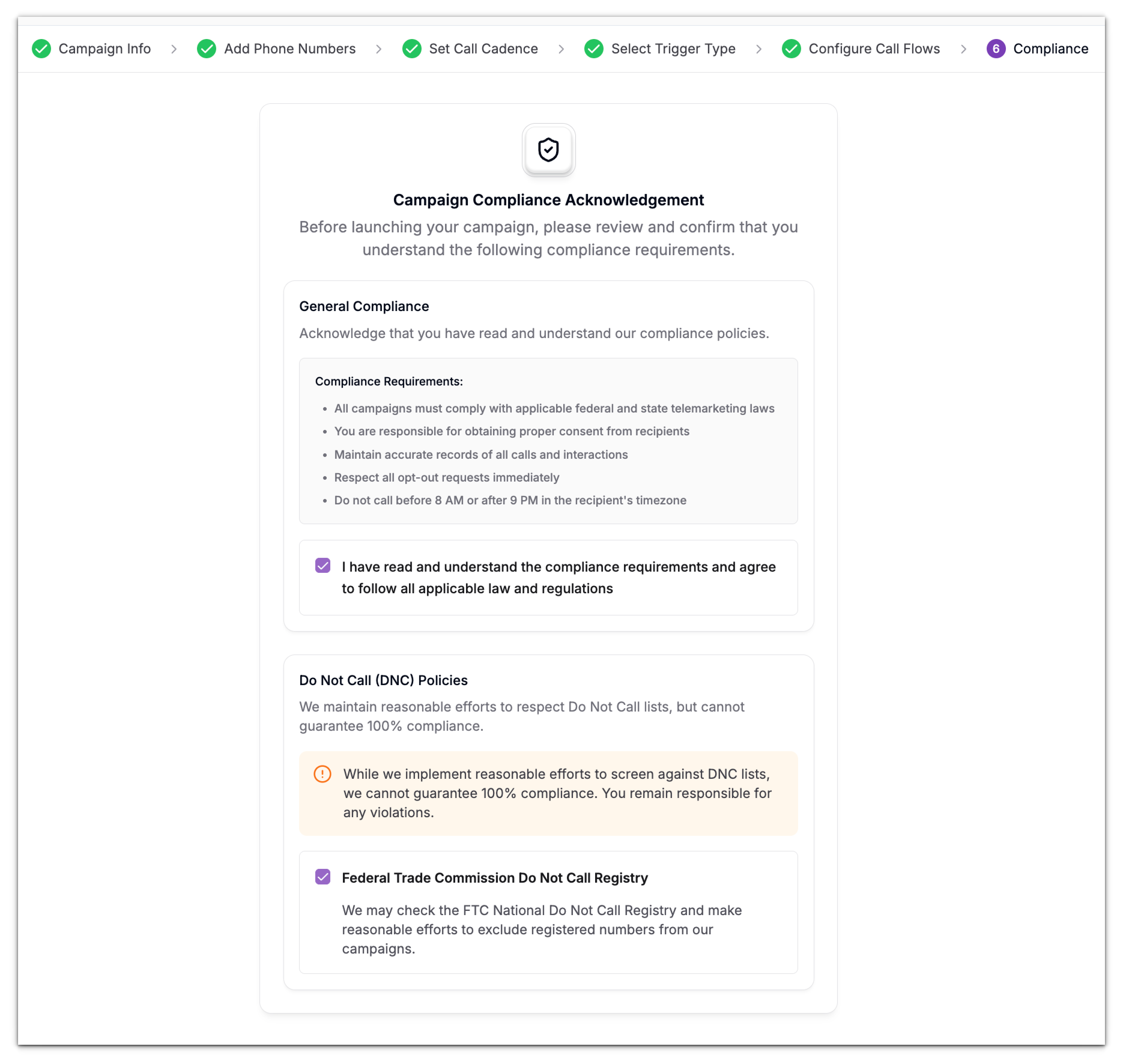
7
Launching and Monitoring the Campaign
After publishing, your campaign appears on the Outbound Calls Dashboard.
This page provides real-time insights into every call attempt and result.When no calls have been made yet, you’ll see a placeholder message:
This page provides real-time insights into every call attempt and result.When no calls have been made yet, you’ll see a placeholder message:
“No calls made yet. Start the campaign to begin calling.”Click Start Campaign to begin. Phonely immediately activates your AI caller, which begins dialing leads according to your scheduled
8
Managing Campaign Status
Once running, your campaign displays an In Progress status badge.
Click it to reveal control options:
Click it to reveal control options:
- Pause Campaign – temporarily stop all outbound calls while retaining data and progress.
- End Campaign – permanently stop the campaign. Once ended, it cannot be resumed.
9
Editing and Optimizing Existing Campaigns
If you need to make adjustments after launch, click Edit Campaign at the top-right of the dashboard.You can modify:
- Campaign name and type.
- Phone numbers used for this campaign and routing method.
- Call cadence and call per hour.
- Trigger type (e.g., reconnect a Google Sheet or update webhook URL).
-
Call flow connections.


